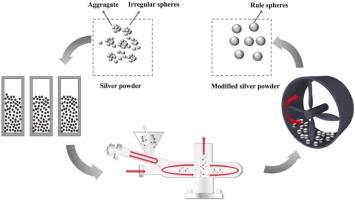Synergistic surface modification of silver powder: Mechanisms for tapped density enhancement and low-temperature sintering
IF 4.6
2区 工程技术
Q2 ENGINEERING, CHEMICAL
引用次数: 0
Abstract
Silver powder, as a pivotal material in electronics and new energy applications, critically depends on its tapped density and sintering activity. This study systematically optimizes the physical properties and sintering performance of micron silver powder through a synergistic surface modification strategy integrating jet milling classification and high-speed shear shaping. Results demonstrate that the modified silver powder exhibits a 40–45 % enhancement in tapped density (5.91 g/cm3), a 50–56 % increase in apparent density (4.01 g/cm3), a narrowed particle size distribution span (reduced from 2.93 to 0.52), and significantly improved flowability (angle of repose: 28.97°). The conductive silver paste formulated with modified powder achieves optimized rheological properties, including a 41.8 % higher 17-s recovery rate (84.5 %) and a 79.08 % reduction in static viscosity. Sintering experiments revealed that the modified silver powder achieved a maximum reduction in sintering temperature of 100 °C, with a relative density exceeding 97.3 % at 650 °C, with grain boundary diffusion and defect density modulation identified as the core mechanisms for densification. This work elucidates the synergistic regulatory mechanisms of surface modification on the sintering behavior of silver powders, aligning with the principles of tapped density enhancement and low-temperature sintering.

银粉的协同表面改性:增强密度和低温烧结的机理
银粉作为电子和新能源领域的关键材料,其密度和烧结性能是银粉发展的关键。本研究采用射流磨矿分级与高速剪切成型相结合的协同表面改性策略,系统优化了微米银粉的物理性能和烧结性能。结果表明,改性后的银粉的出丝密度提高了40 ~ 45% (5.91 g/cm3),表观密度提高了50 ~ 56% (4.01 g/cm3),粒径分布范围缩小(从2.93减小到0.52),流动性显著提高(休止角为28.97°)。用改性银粉配制的导电银浆实现了优化的流变性能,其中17-s回收率提高41.8%(84.5%),静态粘度降低79.08%。烧结实验表明,在烧结温度为100℃时,改性银粉的相对密度最大降低,在650℃时相对密度超过97.3%,晶粒边界扩散和缺陷密度调制是致密化的核心机制。本工作阐明了表面改性对银粉烧结行为的协同调节机制,符合出丝密度增强和低温烧结的原理。
本文章由计算机程序翻译,如有差异,请以英文原文为准。
求助全文
约1分钟内获得全文
求助全文
来源期刊

Powder Technology
工程技术-工程:化工
CiteScore
9.90
自引率
15.40%
发文量
1047
审稿时长
46 days
期刊介绍:
Powder Technology is an International Journal on the Science and Technology of Wet and Dry Particulate Systems. Powder Technology publishes papers on all aspects of the formation of particles and their characterisation and on the study of systems containing particulate solids. No limitation is imposed on the size of the particles, which may range from nanometre scale, as in pigments or aerosols, to that of mined or quarried materials. The following list of topics is not intended to be comprehensive, but rather to indicate typical subjects which fall within the scope of the journal's interests:
Formation and synthesis of particles by precipitation and other methods.
Modification of particles by agglomeration, coating, comminution and attrition.
Characterisation of the size, shape, surface area, pore structure and strength of particles and agglomerates (including the origins and effects of inter particle forces).
Packing, failure, flow and permeability of assemblies of particles.
Particle-particle interactions and suspension rheology.
Handling and processing operations such as slurry flow, fluidization, pneumatic conveying.
Interactions between particles and their environment, including delivery of particulate products to the body.
Applications of particle technology in production of pharmaceuticals, chemicals, foods, pigments, structural, and functional materials and in environmental and energy related matters.
For materials-oriented contributions we are looking for articles revealing the effect of particle/powder characteristics (size, morphology and composition, in that order) on material performance or functionality and, ideally, comparison to any industrial standard.
 求助内容:
求助内容: 应助结果提醒方式:
应助结果提醒方式:


